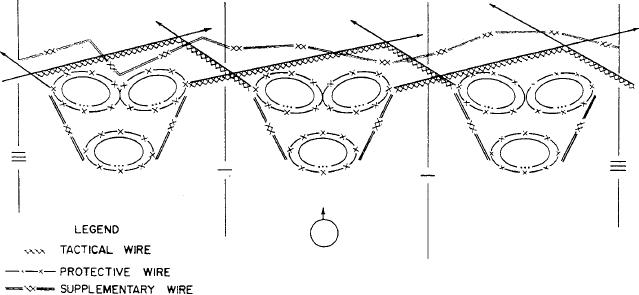
CHAPTER 8
ENTANGLEMENTS
This chapter provides information about the
3. Erect them in irregular and nongeometrical
construction and use of wire entanglements.
traces.
4. Use them in bands or zones wherever
practicable.
BARBED-WIRE ENTANGLEMENTS
5. Coordinate the entanglements with other
Barbed-wire entanglements are artificial obstacles
elements of the defense.
designed to slow the movement of foot troops and, in
some cases, tracked and wheeled vehicles. The materials
used in constructing barbed-wire entanglements are
CLASSIFICATION
relatively lightweight and inexpensive, considering the
protection they afford. You can breach barbed-wire
You should classify entanglements according to use
entanglements by fire but they are built, repaired, and
and depth and whether they are fixed or portable. They
reinforced rapidly.
are classed by use as tactical, protective, or supple-
mentary. The use of these types of entanglements in a
SITE AND LAYOUT
defensive area is shown schematically in figure 8-1.
To be effective, you should select the site and lay
out barbed-wire entanglements to meet the following
Tactical-Wire Entanglements
requirements:
1. Perform the work under friendly observation,
Establish tactical-wire entanglements parallel to
covered by fire, and where practicable, protected by
and along the friendly side of the final protective line.
antipersomel mines, trip flares, and warning devices.
Use them to breakup enemy attack formations and to
2. Conceal the entanglements from enemy
hold the enemy in areas covered by the most intense
observation as far as practicable by incorporating terrain
defensive fire. Extend tactical entanglements across the
features, such as reverse slopes, hedges, woods, paths,
entire front of a position, but you need not make them
and fence lines.
continuous.
Figure 8-1.-Schematic layout of barbed-wire entanglements in a defensive area.
8-1

